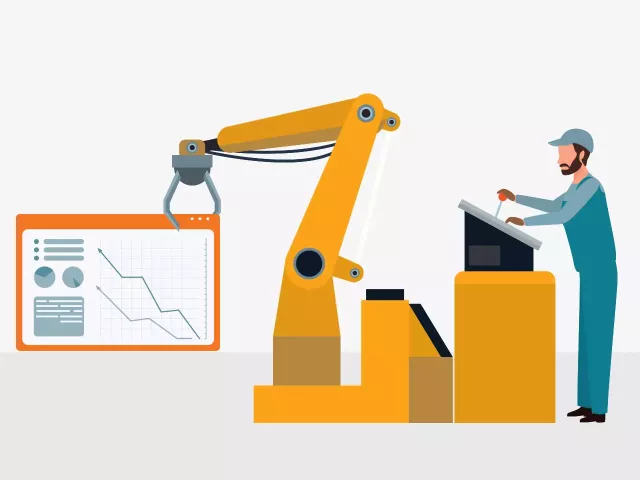
For manufacturers, the pandemic has exposed many weaknesses along the entire value chain. This has resulted in a destabilization of enterprise operations. It has not only reshaped the day-to-day processes of manufacturing, but the industry as a whole.
So what does it take to succeed in the face of so much change? To understand the best path forward, I spoke with Michael Janney, Salesforce’s Vice President-Manufacturing Industry Advisor. During that conversation, Michael and I engaged in an interactive discussion on how the pandemic has impacted the manufacturing industry long-term (and in some cases, permanently), and the need for new approaches and tools for reliable forecasting to enable organizations to become future-ready manufacturers.
Below are video excerpts from the conversation recorded on LinkedIn Live.
Before vs After: Facing Disruption Head On
Question: What would you say are the biggest challenges that have confronted manufacturers and how are they adjusting?
Biggest takeaways:
- Disruption not only hit the supply chain, but it has also rattled the value chain. Customer demand has changed, therefore the way organizations interact with customers has to change as well.
- Companies need to become more efficient not only in the way they operate but also in the way they identify and drive revenue.
- 95 percent of manufacturers expect these changes in operations to be permanent. The “status quo” no longer applies, companies need to adjust to this new way of conducting business to stay competitive and relevant.
How to Make This an Action Item For Your Company:
Product demand is surging. Manufacturers must produce high-quality products faster, more efficiently, and at a lower cost. This is complicated by the need to respond to customized specifications. Intelligent forecasting allows companies to improve customer interactions and outcomes. Intuitive software applies data insights to reveal the right combination of tactics and technology needed to satisfy modern customers. This empowers companies to deploy time, energy, and resources at the right time, in the right places.
Transformation: The Buzzword Heard Around the World. What does that ACTUALLY mean?
Question: We talk a lot about digitization and transformation in manufacturing. Firstly, what is the difference between digital transformation and business process transformation? And secondly, what are you hearing about these topics when you talk to leaders?
Biggest Takeaways:
- Digital transformation is taking a deeper look into your business operations and asking yourself if technology can be applied to increase the efficiency and effectiveness of your processes.
- 95 percent of manufacturers expect some operational changes to be permanent. To make their business operations more resilient, future-ready enterprises are investing in intelligent software and adopting an agile mindset. This means finding logical and efficient ways to combine technology and human labor.
How to Make This an Action Item For Your Company:
Visibility into sales and revenue-generating functions allows you to overcome operational bottlenecks and inefficiencies. Because of new forecasting technology, manufacturers can now slice and dice data in ways that offer them a comprehensive view into the operations of their business. This is essential as organizations reevaluate their forecasting and planning models as part of their COVID-19 re-strategizing.
Forecasting From Start to Finish. What Does That Look Like For Manufacturing?
Question: Why is sales forecasting so important for manufacturers today?
Biggest Takeaways:
- Due to the nature of manufacturing, multiple layered forecasts outside of sales needs are needed to be conducted, i.e. - labor, supply, and production forecasts.
- Having visibility into real-time pipeline metrics is a key capability that’s helped organizations solve forecasting challenges and call numbers with confidence, informing faster, more strategic decisions to accelerate growth.
How to Make This an Action Item For Your Company:
Being able to apply data and intelligence to your forecasting processes is the best first step towards creating reliable and scalable revenue. According to Harvard Business Review, companies that embrace digital technology innovation experience nearly 20 percent higher gross margin than the laggards. By choosing a solution that allows you access to real-time sales insights, you are better able to evaluate and execute on data-backed insights continuously.
What Future-Ready Means for Manufacturers
The pace of change in the manufacturing industry is accelerating faster than ever before. The instability of the past 18 months has brought revenue operations to the forefront for all companies regardless of size or industry.
Becoming more agile is a challenging task, ask any business. But being able to predict demand and pivot operations accordingly is no longer a nice to have option for companies, it’s now an essential function built into all go-to-market plans. This can be accomplished with intelligent sales forecasting solutions. By analyzing sales activities, manufacturing leaders understand when and where to introduce additional processes, resources, strategies, and tactics that have an impact across the entire organization. Long-term investment in quality, customer retention, and operational efficiency helps organizations run like a well-oiled machine.
Interested in a deeper dive into how you can drive predictable revenue growth? Watch the full session here, “Why Manufacturing Needs to Say Bye-Bye to Traditional Forecasting.”



